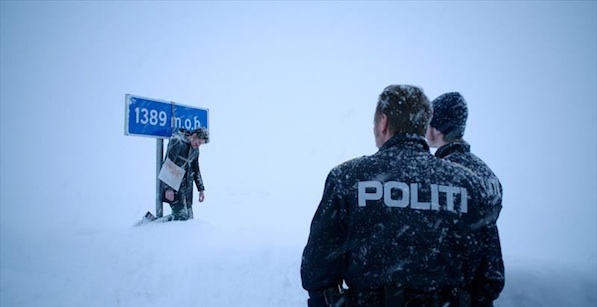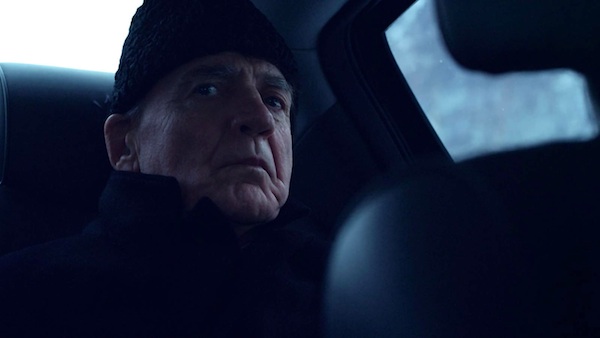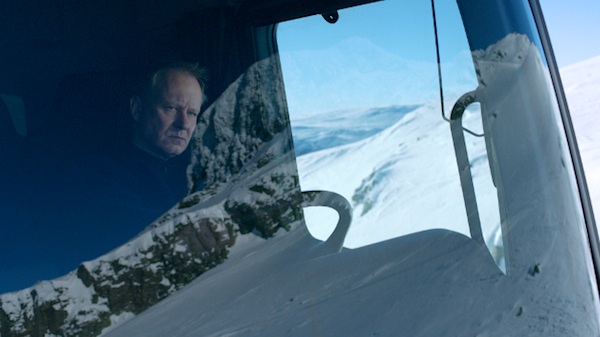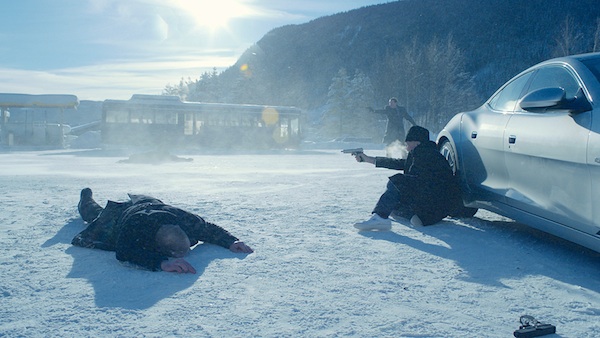In Order of Disappearance, which played this past week at Tribeca, is another spectacular result of Hans Petter Moland and Stellan Skarsgård’s lasting collaboration.The Norwegian director and Swedish actor met almost twenty years ago on the set of Moland’s second film, Zero Kelvin, and made the widely celebrated Aberdeen and A Somewhat Gentle Man before teaming up again for this darkly humored, unusually ironic crime story
Skarsgård is Nils, a coy snow-plough operator recently voted Citizen of the Year, who discovers his merciless alter-ego after his only son is murdered by a local drug cartel. Nils’s kills—inventive in style but often brutal in execution as well as discomfortingly funny—punctuate the film’s speedy, dense action. They also make him a key player in the local conflict between some family-oriented Serbian drug dealers and an overtly sensitive, neurotic criminal and health freak called the Count. Featuring witty dialogue, characters simmering with absurd cultural presumptions, spot-on staging and memorable one-liners, In Order of Disappearance evokes cascades of (at times slightly uncomfortable) laughter. Moland, fulfilling the promise of his award-winning earlier work, proficiently bends genre and mercilessly mocks first-world problems, delivering a brilliantly dark, intelligent comedy with a surprisingly liberal appeal.
Keyframe: Most of the critics, who reviewed In Order of Disappearance are at some point comparing it to Fargo. Is it a compliment or rather a shortcut?
Hans Petter Moland: I think those are a bit simplistic to be honest. Just because there’s snow and blood in the film… Nothing wrong said about the Coen brothers, but what’s wrong with the Marx brothers? I think [In Order… and Fargo] explore two very different territories of human existence. And again, the Coen brothers are wonderful filmmakers, so don’t get me wrong I think it’s just… we have a need to try to place things somewhere in the landscape where we recognize things. And I think there are many other comparisons that are more appropriate, this is my point.
Keyframe: Such as?
Moland: I don’t live in a vacuum, so of course I get influenced by people. I’m a great admirer of Billy Wilder for instance. His wry, very understated and rather dead-pan humor is terrific. And I think maybe in some bizarre way that’s where I have a relationship with the Coens, because we are both appreciative of that type of humor. I love Woody Allen—you might be hard pressed to make an association that our film are comparable in any way. In Crimes and Misdemeanors the great dramatic question Woody Allen poses, is ‘Can time heal old wounds?’ His answer is ;Absolutely yes.’ People even forget that they had made the criminal behavior. So my point is: my influences are much more arbitrary than the most obvious ones.
Keyframe: It’s your fourth collaboration with Stellan Skarsgård. How has your relationship changed over the years?
Moland: We’re good friends, so that doesn’t change. The first time I worked with him he was a big star and I was only making my second film. From the beginning it was a very fruitful relationship and enjoyable friendship. I think we have very different lives. I can maybe go two, three, four years between making movies and he does four to five movies a year. Which means he’s worked with a lot of other directors in between our films; he’s experienced other things. When we meet we have to catch up on each other’s lives and that means we start fresh. Once we get started it’s like ‘Oh, now I remember why I think it’s so fun to work with him.’ I like being courageous together with Stellan.
Keyframe: How did the main character, Nils, change once Stellan ‘inhabited’ it?
Moland: I think the core and the fabric of the character is very instrumental and essential to the story, but some of the brutality has to do with who he is, and his humor, the inadvertent humor that he has. What’s fun in working with Stellan is that he likes to play. So we play, explore, try out new things and sometimes make some attempts that are wrong, but then just try something else. A way of pushing the envelope, if you will. And in this process he’s a huge creative force, so he brings something to it that is completely unpredictable.
Keyframe: How did you enjoy working with the Serbian crew? Their performances are rather outstanding!
Moland: They are wonderful contributors to this film. I love these guys, they are huge talents, very famous in their part of the world, some also outside. Such great, resourceful human beings, no prima donnas; they just came in and gave a great contribution. I hope I get a chance to work with them again. They are very sensitive and skilled artists, but were also brought up in a different tradition, so they bring some other qualities with them, which I think is nice for me to be subjected to, because it reminds you not to get too comfortable. And they bring something to the movie, which, I think, is a great asset.
Keyframe: There are so many situational jokes in the film. Among them the epic scene where a body of a character of Serbian descent is found under a road sign, marking the altitude: 1389 mamsl—or the year of the historical battle of Kosovo…
Moland: It was actually an accident. The sign is really there and we were planning to hang the ‘body’ there anyways; that’s the actual altitude. And I think it was Miki, who said the numbers create the date of battle of Kosovo. So I thought—let’s use it. And we created an extra joke out of it.
Keyframe: Such accidental inspirations are your kind of thing or was this rather an an exception?
Moland: Some… Not to detract anything from the writer, because he’s wonderful. But filmmaking is a dialectic process. First there was an idea, a story that I had. I started talking with Kim Fupz about it, the writer. As we talked he began writing, it went back and forth, it evolved. Then we had a script… but then you go and start researching, get new ideas, and write them down or incorporate them… the DP comes on board, the actors…it keeps… it should keep growing, to me anyway. Part of the fun of making films is this exploration of subject matter. Whether it’s this subject matter or… alcoholism, or whatever it is. [Laughs]. So I don’t keep close track of where things evolve from. I find it terribly uninteresting to make gradation of who was the greatest contributor. Because I think a film is a whole and everybody fill their shoes the best they can.
Keyframe: So the script is not like a Bible to you, but more like a plasticine?
Moland: I’m not very protective of the script. I cut lines, scenes. I write new ones. I do whatever is necessary to make it work and I don’t think I’m unique in this sense; most filmmakers do it. It’s an exploration of the subject matter, like I said. As you keep digging in and getting deeper, you discover new things. So there are new things you want to tell. Or somebody gives a wonderful performance that you have not envisioned before you started and you’re like: ‘Oh my God, how am I… how to operate to include it?’ Or is it great but not great for this film? That’s an obvious question you ask yourself. And if you say:’I cannot not include this gift in the film,’ then you have to start thinking about adjustments needed to make it fit.
Keyframe: So how would you explain your understanding of who the director is?
Moland: I often think of myself as somebody carrying a gigantic tray of Jello across a bumpy field. As you run people come and throw their contributions onto this tray and you have to keep it balanced….But as long as you know that contributions may throw you off balance then you just have to make that little adjustment. And it’s OK.
Keyframe: It’s the attentiveness and the ironical sensitivity that fuels the onscreen sense of humor. Are you yourself such attentive person, a keen observer of reality?
Moland: Yes. I think a rich source of humor in this film derives from the lack of self-knowledge that these characters have. It’s quite evident. There’s nobody in the film who’s aware they are a part of a comedy. They are dead serious, or dead, whichever comes first. The Count for example: he’s a bit childish and immature, feels sorry for himself because he has such a hard life… he’s a real drama queen, he sits and sulks like a little boy in that bath tub, you know.
Keyframe: Exactly, such scenes where the main bad guy is weeping naked in a tub would never be seen in an ordinary crime movie….
Moland: That’s part of what I thought was funny. Part of the ambition of this film was to kind of blow the doors out of the genre limitations that you often feel exist, to see if you can find things that can cohabit the same scene or character, that don’t really fit together. And try to be true to the tone of the story but accepting the fact that now we’re in a little bit of a tragic moment and now here’s a satirical moment… And protect them all. They’re worth equal generosity, which was a big challenge. A lot of times Stellan wasn’t sure and had to just trust me.
Keyframe: I have to know whether the Citizen of the Year contest actually exists.
Moland: No, and perhaps there are some things in this film that are more obvious to Norwegians than foreigners. But this film is a little bit of a fable, a fairytale, an allegorical story. Because every time they’re driving to Oslo we have an altered entrance to the city. So it’s actually like two things that don’t fit together: the road that leads to the city and the city itself. To break up a little bit the realism of the film, to say that this… and it starts in the beginning, with Nils referring to himself as Pathfinder. You know, here is a man living on the edge of the wilderness, being a guide through hostile territory. So it’s a little bit like in an old western, if you will. There is an attempt to stylize and to remove it from reality.
Keyframe: The film is divided into chapters, if you will, with black-and-white drawings, a graphic idea you cam up with pre-shoot or later?
Moland: It’s something that I discovered later, together with my editor actually. We started talking about it, I think, when discussing the violence being a very….or let me rephrase that. I wanted the audience to almost cheer the first time he hits the guy, and then almost choke on this laughter because he snaps and becomes so excessively violent. And the way Stellan punches the guys is pure, naked brutality. So we were saying that we should keep in mind how to not shy away from letting the disgusting aspect of our human impulse to revenge, to surface in the film.
Keyframe: How do you feel about the audience applauding the acts of killing? Guilty?
Moland: Well, I cannot control it. We have in ourselves deep aspirations and cultural varnish about behaving and moral, ethical fashions. But especially for men, even more so than women, we have this sort of primitive impulse to resort to physical violence if we’re wronged or slighted. So the fact that people start laughing when he first hits the guy…but I also think people are shocked that they have laughed. Sometimes people feel inappropriate but you know, morbid and grotesque humor often stems from uncomfortable situations where it’s inappropriate to laugh, but irresistibly funny. It’s a little bit like with people farting in a funeral, which is… you get the picture. I was once at a funeral, where we were carrying the casket and there was a lot of ice that started to melt on it, because it was lying in a chapel for twenty-four hours….
Keyframe: … and we both know what happened later.
Moland: It was very hard to keep it balanced, it rained outside and we had to walk across the cemetery and the grass, it was a little bit slippery… Everybody were like: ‘Oh please, don’t let me slip, please….’ And that’s of course exactly what happened. It’s not appropriate to laugh, but we must’ve looked like a bunch of idiots, so….








